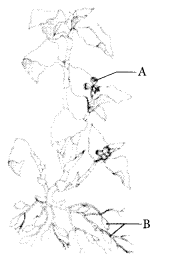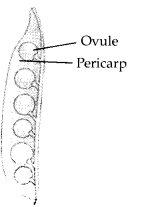NCERT Exemplar Solutions for Class 12 Biology chapter 2 Sexual Reproduction,in Flowering Plants
These Solutions are part of NCERT Exemplar Solutions for Class 12 Biology. Here we have given NCERT Exemplar Solutions for Class 12 Biology chapter 2 Sexual Reproduction,in Flowering Plants
Multiple Choice Questions
Question 1.
Among the terms listed below, those that are not technically correct names for a floral whorl are
(a) androecium
(b) corolla|
(c) (i) and (iv)
(d) (ii) and (iv)
Answer:
(c) : The technically correct terms for the floral whorls are (from outermost to innermost) calyx, corolla, androecium and gynoecium. They are made up of sepals, petals, stamens and carpels, respectively.
Question 2.
Embryo sac is to ovule as________ is to an anther.
(a) stamen
(b) filament
(c) pollen grain
(d) androecium
Answer:
(c) : A typical carpel consist of ovary which can have many ovules. Each ovule has an embryo sac, which in turn has a single egg cell. Similarly, in majority of angiosperms each stamen consists of a bilobed anther, which in turn has two pollen sacs in each lobe, consisting of pollen grains.
Question 3.
In a typical complete, bisexual and hypogynous flower the arrangement of floral whorls on the thalamus from the outermost to the innermost is
(a) calyx, corolla, androecium and gynoecium
(b) calyx, corolla, gynoecium and androecium|
(c) gynoecium, androecium, corolla and calyx
(d) androecium, gynoecium, corolla and calyx.
Answer:
(a)
Question 4.
A dicotyledonous plant bears flowers but never produces fruits and seeds. The most probable cause for the above situation is
(a) plant is dioecious and bears only pistillate flowers
(b) plant is dioecious and bears both pistillate and staminate flowers
(c) plant is monoecious
(d) plant is dioecious and bears only staminate flowers.
Answer:
(d) : Fruits can develop from a single ovary of a single flower (simple fruit) or from several free carpels of a single flower (aggregate) or from whole inflorescence (multiple). In total, fruits develop from ovaries. This is why, a dioecious plant (unisexual) bearing only staminate (male) flowers will not produce fruits, whereas monoecious plants (bisexual) or dioecious plants bearing only pistillate (female) flowers or pistillate and staminate both can bear fruits (pollination).
Question 5.
The outermost and innermost wall layers of microsporangium in an anther are respectively
(a) endothecium and tapetum
(b) epidermis and endodermis
(c) epidermis and middle layer
(d) epidermis and tapetum.
Answer:
(d) : The wall layers of a microsporangium from outermost to innermost are : epidermis, endothecium, middle layers and tapetum. The first three layers generally provide protection and help in dehiscence of anther. Tapetum performs nutritive function for pollen grains.
Question 6.
During microsporogenesis, meiosis occurs in
(a) endothecium
(b) microspore mother cells
(c) microspore tetrads
(d) pollen grains.
Answer:
(b) : Microsporogenesis is the formation of microspores in the form of tetrads, which later separate and are called pollen grains. Microspore mother cell (2n) undergoes meiosis for the formation of haploid pollen grains formed first in the form of spore tetrads.
Question 7.
From among the sets of terms given below, identify those that are associated with the gynoecium.
(a) Stigma, ovule, embryo sac, placenta
(b) Thalamus, pistil, style, ovule
(c) Ovule, ovary, embryo sac, tapetum
(d) Ovule, stamen, ovary, embryo sac
Answer:
(a) : Stigma,is a part of pistil on which pollen grain lands. Each ovary may have many ovules, which have embryo sacs in them. Placenta is a tissue inside ovary to which ovules are attached. Thalamus is the terminal part of the axis of flower which bears all floral appendages. Tapetum is the innermost layer of microsporangium while stamen is component of androecium.
Question 8.
Starting from the innermost part, the correct sequence of parts in an ovule are
(a) egg, nucellus, embryo sac, integument
(b) egg, embryo sac, nucellus, integument
(c) embryo sac, nucellus, integument, egg
(d) egg, integument, embryo sac, rtucellus.
Answer:
(b) : Egg cell is inside the embryo sac in the ovule. The embryo sac is further enclosed by the parenchymatous tissue, nucellus, which later provides nutrition to developing embryo. Nucellus is ultimately surrounded by integuments.
Question 9.
From the statements given below choose the option that are true for a typical female gametophyte of a flowering plant.
(1) It is 8-nudeate and 7-celled at maturity.
(2) It is free-nuclear during the development.
(3) It is situated inside the integument but outside the nucellus.
(4) It has an egg apparatus situated at the chalazal end.
(a) (i) and (iv)
(b) (ii) and (iii)
(c) (i) and (ii)
(d) (ii) and (iv)
Answer:
(c) : Female gametophyte or embryo ‘* sac is present in the nucellus of an ovule. It is formed by free nuclear mitotic divisions of megaspore which forms 8 nucleate structure (4 nuclei each at micropylar and chalazal end). One nucleus from each side moves to the middle to form polar nuclei which later on fuse to form secondary nucleus. The remaining three nuclei at each end get surrounded by wall to form cells. Hence, female gametophyte is 8-nucleate and 7-celled at maturity because of presence of secondary nucleus. Egg apparatus is situated at the micropylar end whereas 3 antipodal s are situated at chalazal end.
Question 10.
Autogamy can occur in a chasmogamous flower if
(a) pollen matures before maturity of ovule
(b) ovules mature before maturity of pollen
(c) both pollen and ovules mature simultaneously
(d) both anther and stigma are of equal lengths.
Answer:
(c) : Autogamy is pollination within a flower, chasmogamous flowers are those in which anthers and stigma are exposed. For autogamy, in such a flower to take place, pollen and ovule should mature simultaneously and anther and stigma should lie close to each other.
Question 11.
Choose the correct statement from the following.
(a) Cleistogamous flowers always exhibit autogamy.
(b) Chasmogamous flowers always exhibit geitonogamy.
(c) Cleistogamous flowers exhibit both autogamy and geitonogamy.
(d) Chasmogamous flowers never exhibit autogamy.
Answer:
(a) : Autogamy is pollination within the same flower. Geitonogamy is pollination between different flowers of same plant. Xenogamy is pollination between flowers of different plants of same species. Cleistogamous flowers (that do not open at all) always exhibit autogamy, where as chasmogamous flowers (with exposed anthers and stigma) can exhibit autogamy, geitonogamy or xenogamy.
Question 12.
A particular species of plant produces light, non-sticky pollen in large numbers and its stigmas are long and feathery. These modifications facilitate pollination by
(a) insects
(b) water
(c) wind
(d) animals
Answer:
(c) : Light, non-sticky pollens produced in large numbers are generally traits of wind pollinated (anemophilous) plants. Insect and animal pollinated plants have sticky pollens. Long and feathery stigma is also characteristic of anemophilous plants. Maize, Cannabis and many grasses are some of the examples of this category.
Question 13.
From among the situations given below, choose the one that prevents both autogamy and geitonogamy.
(a) Monoecious plant bearing unisexual flowers.
(b) Dioecious plant bearing only male or female flowers.
(c) Monoecious plant with bisexual flowers.
(d) Dioecious plant with bisexual flowers.
Answer:
(b) : Monoecious plant (bisexual) bearing either bisexual or unisexual flowers can exhibit both autogamy as well as geitonogamy. Dioecious (unisexual) plants bearing only male or female flowers will not show autogamy or geitonogamy hence, only xenogamy is possible.
Question 14.
In a fertilised embryo sac, the haploid, diploid and triploid structures are
(a) synergid, zygote and primary endosperm nucleus
(b) synergid, antipodal and polar nuclei
(c) antipodal, synergid and primary endosperm nucleus
(d) synergid, polar nuclei and zygote.
Answer:
(a) : Double fertilisation is the fusion of two male gametes brought by a pollen tube with two different cells of the same female gametophyte in order to produce two different structures. It is found only in angiosperms where it was first discovered by Nawaschin in 1898 in Fritillaria and Lilium. Out of the two male gametes one fuses with egg or oosphere to perform generative fertilisation. Generative fertilisation is also called syngamy or true fertilisation. It gives rise to a diploid zygote or oospore. The second male gamete fuses with two haploid polar nuclei or diploid secondary nucleus of the central cell to form a triploid primary endosperm nucleus (PEN). This is called as vegetative fertilisation (or triple fusion).
Question 15.
In an embryo sac, the cells that degenerate after fertilisation are
(a) synergids and primary endosperm cell
(b) synergids and antipodals
(c) antipodals and primary endosperm cell
(d) egg and antipodals.
Answer:
(b)
Question 16.
While planning for an artificial hybridisation programme involving dioecious plants, which of the following steps would not be relevant?
(a) Bagging of female flower
(b) Dusting of pollen on stigma
(c) Emasculation
(d) Collection of pollen
Answer:
(c) : Artificial hybridisation is human performed crossing of two different plants having complementary good traits in order to obtain an overall superior variety. Artificial hybridisation has been used by plant breeders for crop improvement programme. Two precautionary measures in artificial hybridisation are emasculation and bagging. Emasculation is removal of stamens from the floral buds of female parent so that chances of self pollination are eliminated. In case of dioecious (unisexual) plants, emasculation is not required.
Question 17.
In the embryos of a typical dicot and a grass, true homologous structures are
(a) coleorhiza and coleoptile
(b) coleoptile and scutellum
(c) cotyledons and scutellum
(d) hypocotyl and radicle.
Answer:
(c) : During the development of dicot embryo, initially the dicot embryo is globular and undifferentiated. Early embryo with radial symmetry is called proembryo. It is transformed into embryo with the development of radicle, plumule and cotyledons. Two cotyledons differentiate from the sides with a faint plumule in the centre. At this time the embryo becomes heart-shaped. Part of embryo axis between the plumule and cotyledonary node is epicotyl (above the level of cotyledons) while the part between radicle and cotyledonary node is called hypocotyl (below the level of cotyledons). The single cotyledon of monocotyledonous seed (e.g. maize grain) is called scutellum. It occupies the major portion of the embryo regions of grain.
Question 18.
The phenomenon observed in some plants wherein parts of the sexual apparatus is used for forming embryos without fertilisation is called
(a) parthenocarpy
(b) apomixis
(c) vegetative propagation
(d) sexual reproduction.
Answer:
(b) : Apomixis is the term given to any phenomenon that leads to formation of embryo wherein parts of the sexual apparatus are used, but without fertilisation. Fertilisation is also absent in vegetative propagation, but parts of sexual apparatus are not involved. An example of apomixis is Citrus.
Question 19.
In a flower, if the megaspore mother cell forms megaspores without undergoing meiosis and if one of the megaspores develops into an embryo sac, its nuclei would be
(a) haploid
(b) diploid
(c) a few haploid and a few diploid
(d) with varying ploidy.
Answer:
(b)
Question 20.
The phenomenon wherein, the ovary develops into a fruit without fertilisation is called
(a) parthenocarpy
(b) apomixis
(c) asexual reproduction
(d) sexual reproduction.
Answer:
(a) : Fertilised ovary is technically called fruit. But if ovary develops into fruit, without fertilisation, it is called parthenocarpic fruit. Such fruits are generally seedless. Some common examples found in nature are : Citrus, banana, etc. Parthenocarpy can also be artificially induced by the application of certain plant hormones, specially, auxin and gibberellins.
Very Short Answer Type Questions
Question 1.
Name the component cells of the ‘egg apparatus’ in an embryo sac.
Answer:
Egg apparatus consists of two synergids and one egg cell.
Question 2.
Name the part of gynoecium that determines the compatible nature of pollen grain.
Answer:
Stigma is that part of gynoecium which determines the compatible nature of pollen grain.
Question 3.
Name the common function that cotyledons and nucellus perform.
Answer:
Common function of nucellus and cotyledons is to provide nourishment.
Question 4.
Complete the following flow chart:

Answer:

Question 5.
Indicate the stages where meiosis and mitosis occur (1, 2 or 3) in the flow chart.
Megaspore mother cell ——-1—— > Megaspores –2— > Embryo sac —-3—- > Egg
Answer:
1 = Meiosis 2 = Mitosis 3 = Mitosis
In the diagram given below, show the path of a pollen tube from the pollen on the stigma into the embryo sac. Name the components of egg apparatus
Question 6.
In the diagram given below, show the path of a pollen tube from the pollen on the stigma into the embryo sac. Name the components of egg apparatus.
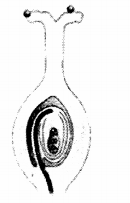
Answer:
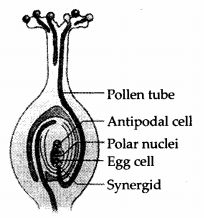
Egg apparatus consists of two synergids and one egg cell.
Question 7.
Name the parts of pistil which develop into fruit and seeds.
Answer:
Fruit develops from ovary and seeds develop from ovules of a pistil.
Question 8.
In case of polyembryony, if an embryo develops from the synergid and another from the nucellus, which is haploid and which is diploid?
Answer:
In case of polyembryony, if an embryo develops from synergid, it will be haploid and if it develops from nucellus, it will be diploid.
Question 9.
Can an unfertilised, apomictic embryo sac give rise to a diploid embryo? If yes, then how?
Answer:
Apomictic embryo sac develops without the involvement of meiosis and syngamy. Here, a diploid embryo is formed from diploid egg cell or from some other diploid cell of embryo sac.
Question 10.
Which are the three cells found in a pollen grain when it is shed at the three celled stage?
Answer:
The three cells found in a pollen grain when it is shed at the three celled stage are two male gametes and one vegetative cell.
Question 11.
What is self-incompatibility?
Answer:
If a pistil carrying functional female gametes fails to set seeds following pollination with viable and fertile pollen, capable of bringing about fertilisation in another pistil, the two are said to be incompatible, and the phenomenon is known as sexual incompatibility. Sexual incompatibility may be interspecific (between individuals of different species) or intraspecific (between individuals of the same species). The latter is also called self-incompatibility.
Question 12.
Name the type of pollination in self incompatible plants.
Answer:
Self incompatible plants do not undergo self pollination. They can undergo only cross pollination.
Question 13.
Draw the diagram of a mature embryo sac and show its 8-nudeate, 7-celled nature. Show the following parts: antipodals, synergids, egg, central cell, polar nuclei.
Answer:
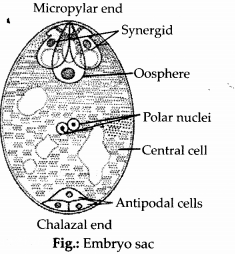
Question 14.
Which is the triploid tissue in a fertilised ovule? How is the triploid condition achieved?
Answer:
Endosperm is the triploid tissue in a fertilised ovule which is formed by the division of Primary Endosperm Nucleus (PEN). PEN is formed by the fusion of one male gamete (haploid) with secondary nucleus (diploid) hence, it is triploid.
Question 15.
Are pollination and fertilisation necessary in apomixis? Give reasons.
Answer:
In apomixis, there is no need of pollination and fertilisation. Embryo can develop directly from the nucellus or synergid or egg cell.
Question 16.
Identify the type of carpel with the help of diagrams given below:
Answer:
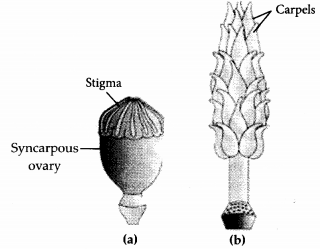
(a) Polycarpellary syncarpous
(b) Polycarpellary apocarpous
Question 17.
How is, pollination carried out in water plants?
Answer:
Plants which occur below the water level undergo epihydrophily or hypohydrophily,i.e pollination takes place by the agency of water. Aquatic plants which are emerged or present at the water surface can undergo entomophily, anemophily or epihydrophily.
Question 18.
What is the function of the two male gametes produced by each pollen grain in angiosperms?
Answer:
The function of the two male gametes produced by each pollen grain in angiosperms are as follows:
- One of the male gamete fuses with egg cell to produce zygote (2n).
- Second male gamete fuses with two polar nuclei/diploid secondary nucleus to form primary endosperm nucleus (3n)
Short Answer Type Questions
Question 1.
List three strategies that a bisexual chasmogamous.flower can evolve to prevent self pollination (autogamy).
Answer:
Strategies that a bisexual chasmogamous flower can evolve to prevent self pollination are as follows:
- Pollen release and stigma receptivity is not synchronised. Either the pollen is released before stigma is receptive or stigma becomes receptive much before pollen release.
- Anther and stigma are placed at different positions, so that pollen cannot come in contact with stigma.
- When the pollen of the flower reach the stigma of the same flower, pollen grains
- do not germinate and the phenomenon is called self-incompatibility.
Question 2.
Given below are the events that are observed in an artificial hybridisation programme. Arrange them in the correct sequential order in which they are followed in the hybridisation programme.
(a) Re-bagging
(b) Selection of parents
(c) Bagging
(d) Dusting the pollen on stigma
(e) Emasculation
(f) Collection of pollen from male parent.
Answer:
(b) —> (e) —> (c) —> (f) —> (d) —> (a)
Question 3.
Vivipary automatically limits the number of offsprings in a litter. How?
Answer:
Viviparity is a form of reproduction in animals in which the development of embryos takes place within the mother’s/ female parent’s body. The embryo obtains its nourishment directly from mother via placenta or by other means and subsequently mother gives birth to the full term young one. It is common in most mammals. Viviparity limits the number of offspring in a litter due to the following reasons:
- As the number of eggs released during ovulation are limited during oestrous or menstrual cycles so the number of eggs fertilised during reproductive cycle of female are also limited.
- As the entire period of development called gestation is passed within the mother’s/female parent’s body; it restricts the number of embryo that can develop together at one time.
- During gestation no ova or egg are released.
Question 4.
Does self incompatibility impose any restrictions on autogamy? Give reasons and suggest the method of pollination in such plants.
Answer:
Self incompatibility is the phenomenon in which self pollens fail to germinate on stigma of pistil. It is a gene physiological process which is controlled by single gene S. If pollen and pistil will have the S alleles in common, pollens will not be functional on that pistil. As self pollens will have common S alleles with pistil (of the same flower), self pollination (autogamy) cannot take place in self incompatible plants. Cross pollens on the other hand, will not have common S alleles with pistil and hence, cross pollination can easily take place in such plants.
Question 5.
In the given diagram, write the names of parts shown with lines.
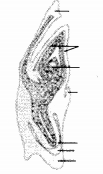
Answer:
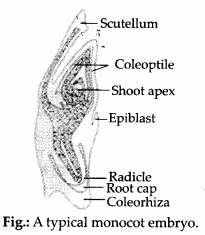
Question 6.
What is polyembryony and how can it be commercially exploited?
Answer:
The phenomenon of having more than one embryo is called polyembryony, e.g., onion, groundnut.
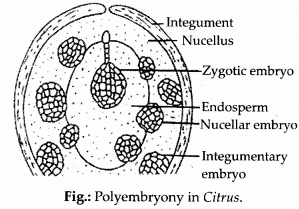
Polyembryony is practically important because genetically uniform parental type seedlings are obtained from nucellar embryos. Nucellar embryos are superior to those obtained by vegetative propagation because nucellar embryo seedlings are disease free and maintain their superiority for long time.
Question 7.
Are parthenocarpy and apomixis different phenomena? Discuss their benefits.
Answer:
Parthenocarpy is production and development of seedless fruits. Apomixis is a type of sexual reproduction which does not involve meiosis and syngamy and produces seeds without fertilisation.
Benefits of parthenocarpy are as follows:
(1) It produces fruits which do not contain irritant seeds.
(2) Processing of fruits by food industry requires the removal of seeds which is quite difficult. Therefore, seedless fruits are preferred by food industry.
(3) Fruits can be developed inside green houses where pollinators are not available.
Benefits of apomixis are as follows:
- Production of hybrid seeds is costly and hence the cost of hybrid seeds becomes too expensive for the farmers. If these hybrids are made into apomicts, there is no segregation of characters in the hybrid progeny. Then the farmers can keep on using the hybrid seeds to raise new crop year after year and do not have to buy hybrid seeds every year.
- Adventive embryos are better clones than cuttings.
- Embryos formed through apomixis are generally free from infections.
Question 8.
Why does the zygote begin to divide only after the division of primary endosperm cell (PEC)?
Answer:
Endosperm development precedes embryo development. The primary endo¬sperm cell divides repeatedly and forms the triploid endosperm tissue. The cells of this tissue are filled with reserve food materials and are used for the nutrition of the developing embryo at the micropylar end of the embryo sac. This is an adaptation to provide assured nutrition to the developing embryo.
Question 9.
The generative cell of a two-celled pollen divides in the pollen tube but not in a three- celled pollen. Give reasons.
Answer:
In some plants pollen grains are shed at 2 celled stage whereas in others pollen grains are shed at 3 celled stage. The pollens which are shed at 2 celled stage contain vegetative cell and a generative cell. At the time of pollen germination, generative cell divides to form two male gametes in the pollen tube.
On the other hand, in case of pollens which are shed at 3 celled stage, the generative cell has already divided to form two male gametes before pollination or pollen germination, i.e., formation of pollen tube.
Question 10.
In the ,figure given below, label the following parts: .
Male gametes, egg cell, polar nuclei, synergid and pollen tube.
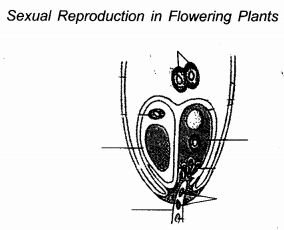
Answer:
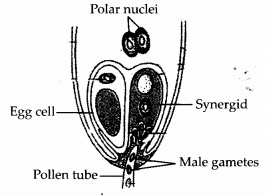
Long Answer Type Questions
Question 1.
Starting with the zygote, draw the diagrams of the different stages of embryo development in a dicot.
Answer:
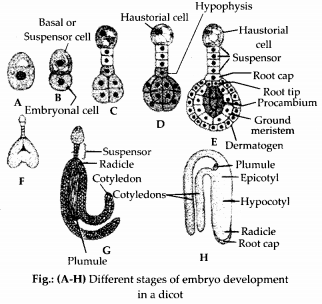
Question 2.
What are the possible types of pollinations in chasmogamous flowers. Give reasons.
Answer:
Chasmogamous flowers are the flowers with stamens and stigma exposed .They may undergo self pollination or cross pollination.
(1) Self pollination in chasmogamous flowers : Bisexual flowers where stigma and the stamens both mature almost at the same time can undergo autogamy or geitonogamy.
- Autogamy – Transfer of pollen grains from anther of a flower to the stigma of the same flower.
- Geitonogamy – When pollen grains from one flower are deposited on the stigma of another flower borne on the same plant.
(2) Cross pollination in chasmogamous flowers : Transfer of pollen grains from anther of a flower to the stigma of different flower growing on different plant of same species. Cross pollination is carried by various abiotic agents like wind and water or by biotic agents like insects, birds and animals etc.
Question 3.
With a neat, labelled diagram, describe the parts of a mature angiosperm embryo sac. Mention the role of synergids.
Answer:
Neat and labelled diagram of mature angiospermic embryo sac is as follows :
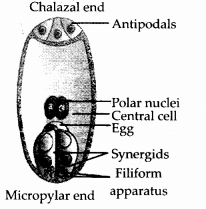
Ovule is an integumented megasporangium that encloses an embryo sac. Common type of ovule is anatropous. Parts of mature angiospermic ovule are:
(1) Funicle : It is the stalk of the ovule. It is attached to placenta by funicle. In anatropous ovules the funicle is fused with the body of the ovule lengthwise to form raphe. Place of union of funicle and the body of ovule is called hilum.
(2) Integuments : They are one or two cuticularised coverings of the ovule. The place of origin of integuments is called chalaza. A pore’occurring on one side of ovule where integuments are absent is known as micropyle.
(3) Nucellus : It is parenchymatous tissue contained in the ovule.
(4) Embryo sac : It is female gametophyte which is covered by a thin membrane. Embryo sac has seven cells. Three cells form egg apparatus towards micropylar end. There are two synergids and one egg or oosphere in the egg apparatus. Three cells on the opposite side are called antipodal cells. The seventh cell of the embryo sac is the largest cell called central cell. Central cell has two polar nuclei which may fuse to form a diploid secondary nucleus. Synergids are shortlived (one of them degenerates long before fertilisation and second after entry of pollen tube into embryo sac).
These synergids help :
- In growth of pollen tube towards egg by secreting chemotropically active substances.
- In nutrition of embryo sac by absorption and transport of food from nucellus through their filiform apparatus.
Filiform apparatus in the form of finger like projections from cell wall is present in upper part of each synergid. The filiform apparatus is useful for the absorption and transportation of
materials from the nucellus to the embryo sac. Hook like structures help in easy penetration of pollen tube and liberation of male gamete from the pollen tube.
Question 4.
Draw the diagram of a microsporangium and label its wall layers. Write briefly on the role of the endothecium.
Answer:

Question 5.
Endothecium protects the sporogenous tissue and helps in dehiscence of pollen grains.
Embryo sacs of some apomictic species appear normal but contain diploid cells. Suggest a suitable explanation for the condition.
Answer:
Embryo sacs of some apomictic species appear normal but contain diploid cells, because embryo sacs either develop from diploid nucellar cells or from diploid megaspore mother cells without undergoing meiosis. It leads to formation of apomictic diploid embryos.
We hope the NCERT Exemplar Solutions for Class 12 Biology chapter 2 Sexual Reproduction,in Flowering Plants help you. If you have any query regarding NCERT Exemplar Solutions for Class 12 Biology chapter 2 Sexual Reproduction,in Flowering Plants, drop a comment below and we will get back to you at the earliest.
